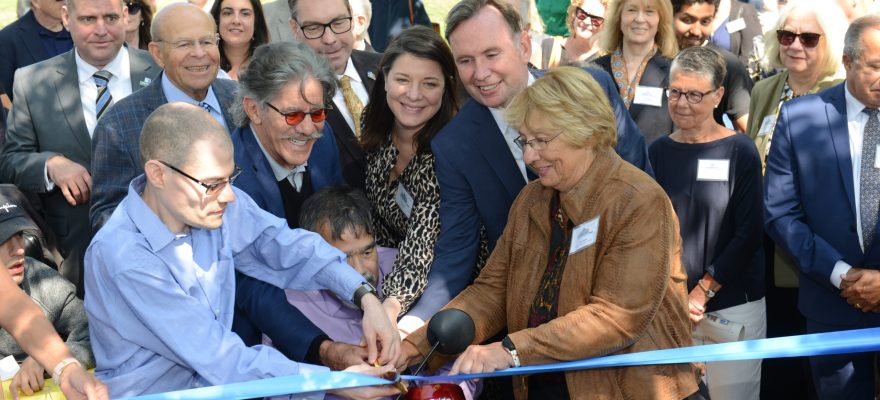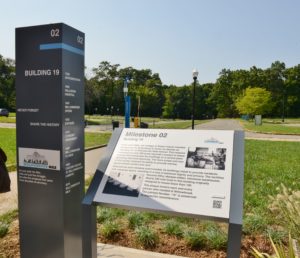
The College of Staten Island (CSI) held a ceremony to officially open the Willowbrook Mile last week. The event was part of the college’s Year of Willowbrook programming that raises awareness about the history of its grounds, which was formerly the site of the infamous Willowbrook State School.
The Willowbrook Mile is a 2.2-mile memorial trail on the campuses of CSI, the New York State Office of People with Developmental Disabilities and the Elizabeth Connelly Center. It features 12 informational stations where people can learn about the Willowbrook State School, which closed in 1987 due to deplorable conditions.
The walkway is part of CSI’s broader Willowbrook Legacy Project.
“The project is about how the college can honor having inherited the history of this place where we are and live up to the promises that were made when Willowbrook was closed,” Catherine Lavender, co-chair of the project, said.
Among those promises were that people with disabilities would not be isolated and would be given their full human dignity.
Nora Santiago, who co-chairs the legacy project with Lavender, underscored the importance of the newly opened walkway.
“Cementing this project into the history of our campus is an important milestone for the College of Staten Island and has special significance to me,” Santiago said. “The mile commemorates the decades of struggle that took place at Willowbrook and other institutions and celebrates how far we’ve come from the tragic institutionalization of people with disabilities. As a mother of a young man with autism, I strive to be a fervent advocate to ensure that my son Nathaniel and others will avoid a similar outcome.”

About the Willowbrook State School
The Willowbrook State School opened in 1947. It was intended to serve as a model of treatment for persons with intellectual and other disabilities. But the scope and size of the more-than-380-acre institution impaired its ability to provide normal, personalized comfort and care.
There were many staff members who did the best they could, but that wasn’t always the case. The overcrowding often led to abuse and filthy living conditions. Residents were confined for long periods, and there was a failure to provide schooling and therapy. There was inadequate clothing, meals and toilet facilities, and much more.
As conditions worsened, residents’ families and staff urged change. By the 1970s, they invited reporters to share the story more widely. Media coverage—including a televised expose by Geraldo Rivera— and this activism led to a lawsuit resulting in a 1975 Consent Judgment. This ordered that Willowbrook residents receive humane treatment and adequate clinical and educational services. It also set in motion the school’s eventual closure. Residents were moved to community living arrangements. They lived in smaller group homes, they had better care and were able to maintain contact with family.
Willowbrook’s closure prompted other large institutions across the state and eventually across the country to close, too.
“It triggered this massive change in ways people with intellectual and developmental disabilities lived in the United States,” Lavender said.
In 1993, CSI, part of the City University of New York, moved onto the site. Many graduate and undergraduate programs are offered here. These include training for professionals in fields that address the needs of persons with disabilities.
About the Willowbrook Mile and the Willowbrook Legacy Project
Since CSI moved onto the site, professors have held lectures to remind students and the community about the horrors that took place at Willowbrook. Eventually, fundraising was started to create the memorial walkway. But it was in 2021, when the Willowbrook Legacy Project was officially launched, that plans for the walkway and other legacy projects really took off.
Funds mostly came from NYS Assembly Member Michael Cusick and many private donors. Not surprisingly, construction of the walkway was delayed due to the COVID-19 pandemic. But once the money was secured, Lavender and her team began the necessary research needed to show the history of Willowbrook along the trail.
“We had to enter into this process of writing all of the text that would be seen as you walk along the mile,” Lavender explained. “There are stations at different points where you can read about the history. That process was done by a committee made up of people who represented different stakeholders. These included people who were at Willowbrook, who worked there, experts in the fields of disability studies and advocates.”
Designing the Trail
The trail was designed by Jorma Loci, an architect who works at CSI. Like the text posted along the trail, the designs also had to be approved by stakeholders.
“It was a complicated process, but very fruitful,” Lavender said.
Everyone involved in the project wanted to ensure that the Willowbrook Mile is accessible to all. The committee took measures to make sure people of all abilities can visit, including those with physical disabilities.
“I have a background in public history,” Lavender said. “That’s part of what public historians do. They work with people whose story it is to try to help them to tell their story in a way that’s accessible to everybody.”
The Willowbrook Mile is outdoors and open to the public. To learn more about the Willowbrook Legacy Project, visit the website, or follow CSI on Facebook.
Wanna read more stuff like this? Get our newsletters packed with ideas, events, and information for parents in Staten Island.

